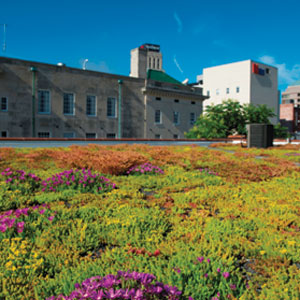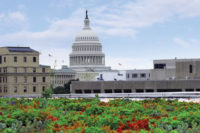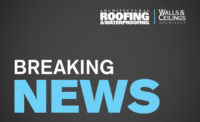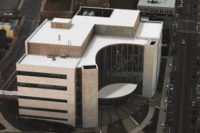A green roof is a supplemental system that covers a conventional roof with a layer of vegetation. Architects and designers involved in green building know the proven benefits of green roofs: retaining stormwater, improving buildings’ thermal performance and extending the life of roofs’ waterproof membranes. However, architects and designers may be less certain about how to ensure the success of green roof installations.
Based on a combined 15 years of academic research and hands-on experience with 400 green roof projects, I have distilled a summary set of critical success factors:
Green Roof Goal: It is essential to start project planning with the purpose of the green roof. Is it intended primarily to deliver environmental, cost-saving benefits? Is it expected to serve as a decorative landscape element? Is it for urban farming? To set the direction for any project, first define the purpose of the green roof, establish priorities for specific goals and align stakeholder expectations.
Architectural Factors: Roof structural load capacity is the most basic issue. Extensive green roofs range from 3 to 6 inches deep with saturated weight loads as little as 8 pounds per square foot. The advantage of lightweight green roof assembles is significant for older building retrofits, including historic buildings, or for new projects with limited load capacity such as buildings with wood frame construction or roofs with long structural spans.
Roof slope angle is a significant design factor but often overlooked. Roofs sloped from 10 to 45 degrees require green roofs with more depth and subsequent heavier load-bearing capacity. Specialized components to retain and stabilize the growing medium “soil” layer against erosion and slippage should be included as well. In addition, access for maintenance and for building occupants has to be taken into account to prevent foot traffic damage to the vegetation or underlayments.

Location: Regional climate determines what type of green roof and plants you can and should have. Cooler summer climates in temperate regions allow shallower rooting depths, a wider array of plant options and shorter initial maintenance periods. Areas with prolonged, hot summers, like the Southeast, require deeper rooting depths, plant species that are particularly heat and drought tolerant, and longer periods of initial maintenance with irrigation.
Maintenance Expectations: Every green roof needs a maintenance plan for initial establishment and successful long-term performance. Maintenance considerations should be included in project planning and system specification.
Low-profile, lightweight extensive green roofs require minimal long-term maintenance. Deeper systems, including intensive green roofs from 8 inches to 1 foot or more in depth, accommodate more types of plants but need more maintenance. Intensive and mixed-type installations, especially those with intricate designs featuring solid sections of single species or specialty accent plants, must be tended like landscaped gardens. Therefore, they require labor-intensive and costly maintenance service plans.
System Specification: No one type of green roof, and no specific green roof system, will work for all projects. Goals, architectural factors, location and maintenance should guide decisions as to what kind of roof to install and which system to specify.
The green roof industry in the U.S. and Canada is about one decade old; in Europe, it has been established for several decades. There are many new systems on the market in North America with limited track records. Reinvented wheels are not necessarily better.
All manufacturers can point to short-term successes. Inquire about their systems’ long-term performance…and failures.
Do your homework. Tap the experience of your peers and colleagues. Seek out knowledgeable experts. And, look for systems with credible third-party certifications (for example, for sustainability and wind uplift resistance).
Install the Specified System: Many green roof projects are compromised by “or equivalent” specification. Not all product offerings for any given type of green roof system are truly equivalent, or even include all the necessary components for complete green roof assemblies. Be cautious that value engineering does not engineer the value right out of your project.
Proper Installation: Without bid requirements for actual experience with the specified system, going with the lowest bidder often results in poor workmanship, substituted or misused components, and compromised warranty protection. It pays to rely on system-certified installers with proven experience.
Green Roof Plant Considerations
Species Diversity: Variety promotes a dynamic plant community that adapts to the conditions and microclimates of each rooftop. Plant palettes should include a minimum of eight to 12 different varieties of sedum and other succulents, which can be supplemented from a limited array of proven, herbaceous accent plants.
Locally Grown: Plants selected for, and grown within, the USDA horticultural zone where a green roof is to be installed are adapted to the regional climate for a healthier, sustainable green roof. Using regional horticultural suppliers also supports local economies, lowers shipping costs and increases LEED credit potential.
Full-Grown Plants: Installing green roofs with pre-grown plants reduces one of the biggest risks of green roof failure—that a green roof never greens up. Extensive vegetation coverage (at least 85 percent) with mature plants creates an immediately functional and beautiful green roof that will be more successful for the long term with less maintenance.
Image courtesy of Xero Flor America






